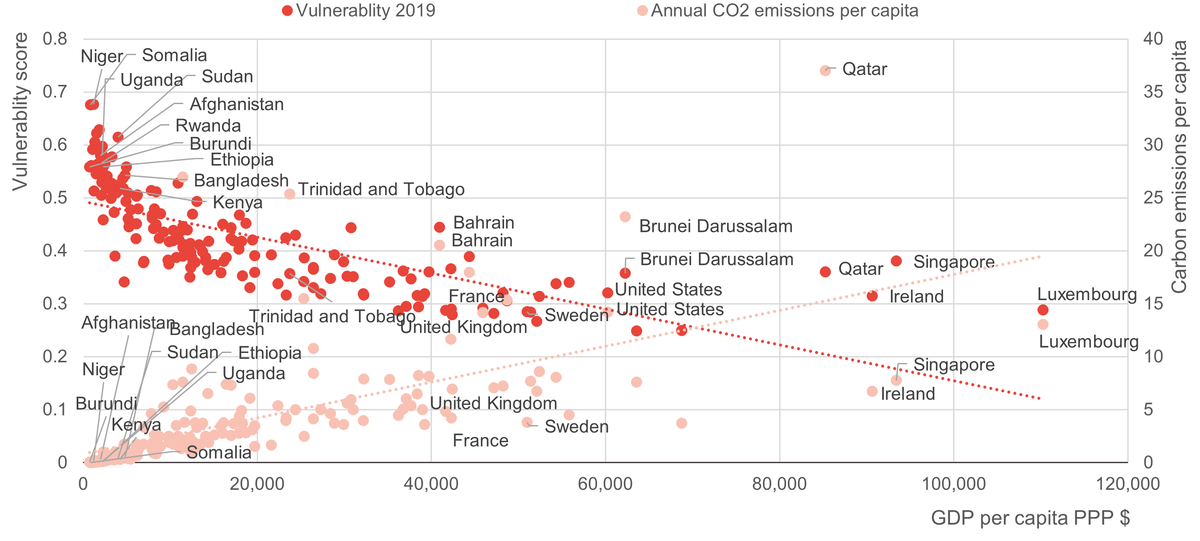To leave no one behind, we must use data to address climate inequalities
As climate change compounds and exacerbates global inequalities, DI’s Deborah Hardoon explains how data can be used to protect those most vulnerable to its impacts.
Development Initiatives seeks to improve the availability and use of data and evidence in policies and plans that seek to tackle poverty and inequality. There is a growing body of data and evidence on the causes and consequences of climate change and the associated impacts on the wellbeing of different people and communities around the world. However, we are still a long way from seeing it being applied in a way that prevents climate change from exacerbating the most extreme global inequalities and leaving people behind.
Climate change causes and effects: Compounding global inequalities
Agenda 2030 compels all signatories to leave no one behind, that is, to identify the furthest behind and meet their complex and multidimensional needs, whilst tackling the structural inequalities that exclude people. Unfortunately, in the context of climate change, this commitment is left wanting.
In our 2022 global inequality factsheet , we presented data that illustrated how people in the lowest income countries, already facing poverty in multiple dimensions, are also at the greatest risk from shocks and hazards related to climate change that further threaten their wellbeing.
Compounding the inequality of the impacts of climate change is the fact that, generally speaking, the people most vulnerable to climate change are also those least responsible for it. Living in countries where access to energy remains limited for many, and where consumption of high carbon-emitting sources such as flights is much lower, means that their contribution to climate change is considerably lower than people in high-income countries, who have enjoyed decades of easy access to cheap fossil fuel-based energy.
Figure 1: People in countries with the lowest incomes per capita, who have contributed the least carbon emissions, are the most vulnerable to the impacts of climate change

placeholder
Source: Vulnerability scores from Notre Dame Global Adaptation Initiative. Available at: https://gain.nd.edu/our-work/country-index/download-data/ and CO2 emissions from Our World in Data and GDP from World Bank
This is acutely demonstrated by recent flooding in Pakistan, a country in which a quarter of the population still don’t have access to electricity and 38% of people were already experiencing multidimensional poverty prior to the flooding. Pakistan is responsible for just 1% of global emissions, but it is one of most climate-vulnerable countries in the world. [1]
The need for better data to inform decision-making
It is clear that people dependent on agriculture, but without irrigation or stocks; those in low-lying lands, with no flood protection infrastructure, and people without social protection coverage and the resilience necessary to respond to the onset of crisis are suffering the worst effects of climate change and are least able to recover without assistance. But important data gaps remain, particularly when it comes to understanding the individuals and groups that are most impacted, and their differentiated needs. As we point out in this assessment of data on risk, there is a real need for more timely, disaggregated data that is nationally owned to understand climate-related impacts on poverty and inequality.
Whether this data will be used to inform decisions depends on human, cultural and systemic factors. The barriers preventing climate data being used to drive progressive policies that reduce poverty and inequality are profound. The inequalities between countries revealed in the data point to a need for substantial shifts in emissions, power and resources to tackle the challenges that lie ahead, but emissions and finance targets have been repeatedly missed. Higher-income countries are already falling far short of their climate commitments to vulnerable populations and there has been little support for discreet loss and damage finance to date.
As the costs of climate change continue to mount, it’s critical that we leverage data on its causes and impacts to prevent inequality from becoming further entrenched. This is a fundamental prerequisite to meeting the commitment to leave no one behind.
Notes
- 1 Pakistan ranks 146 out of 182 in the ND-GAIN Country Index, which “summarizes a country's vulnerability to climate change and other global challenges in combination with its readiness to improve resilience.” At 182, Chad is the most vulnerable country in the world (of the countries for which a score is given): https://gain.nd.edu/our-work/country-index/rankings/
Related content
Climate finance: Accounting and accountability
Inadequate reporting and tracking of climate finance data leads to reduced donor accountability. Ahead of COP27, this briefing examines five major issues.
Loss and Damage: Building resilience to crisis
As Denmark becomes the first UN member to pledge funding to Loss and Damage, DI’s Erica Mason explains how this financing can embed resilience in the humanitarian system.
Climate finance to Africa: What we know about ODA
This blog explores how better climate finance to countries experiencing protracted crisis can contribute towards our global future.